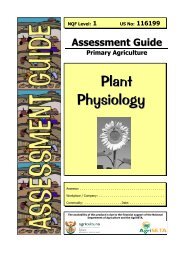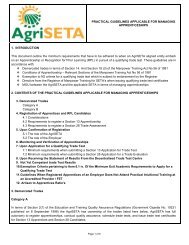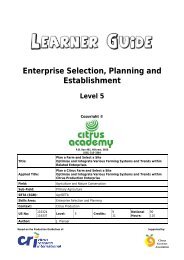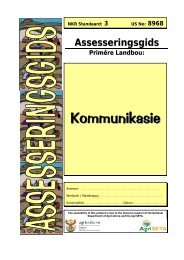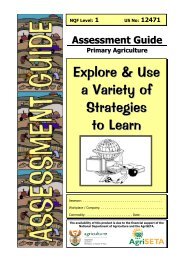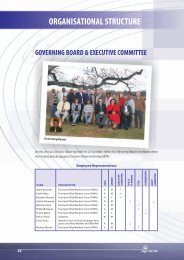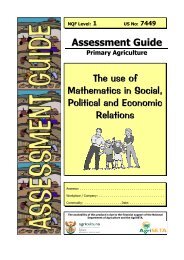Evaluate Basic External Animal Anatomy and Morphology - AgriSETA
Evaluate Basic External Animal Anatomy and Morphology - AgriSETA
Evaluate Basic External Animal Anatomy and Morphology - AgriSETA
- No tags were found...
You also want an ePaper? Increase the reach of your titles
YUMPU automatically turns print PDFs into web optimized ePapers that Google loves.
<strong>Evaluate</strong> <strong>Basic</strong> <strong>External</strong> <strong>Animal</strong> <strong>Anatomy</strong> <strong>and</strong> <strong>Morphology</strong>Primary Agriculture NQF Level 1 Unit St<strong>and</strong>ard No: 116173171.3 ReptilesA reptile is a cold-blooded animal which means that it is not capable of keeping itsbody temperature constant like the mammals <strong>and</strong> the birds.This group of animals includes snakes, lizards, chameleons, crocodiles <strong>and</strong> tortoises.The lizard is a good example to study but any other species of reptile can bestudied.We will study the external anatomy of the lizard.Lizards HabitatThe lizard lives among stones, plants, <strong>and</strong> old trees. Some are welladapted to even live in very harsh circumstances like deserts. They are shyanimals <strong>and</strong> live on insects. In winter they are inactive <strong>and</strong> spend this timein a well-sheltered environment. The best time to study them is during thewarmer months. BodyThe body is elongated <strong>and</strong> slightly flattened from top to bottom. Body coverThe skin has horny scales arranged like roof tiles. The scales on the headare larger <strong>and</strong> lie next to each other. They are called shields. The skin ofthe lizard is dry <strong>and</strong> is shed once a year. There are no gl<strong>and</strong>s in the skin. The headThe head of the lizard is triangular <strong>and</strong> flattened from top to bottom. Thefollowing are found on the head:• The mouthThe mouth is found on the front of the head <strong>and</strong> is broad.A single row of fine similar teeth occurs on both the upper<strong>and</strong> lower jaw. A long tongue is attached at the back ofthe mouth. Prey can be caught <strong>and</strong> held with the teeth before it isswallowed whole.• The eyesLarge eyes occur on each side of the head with an upper <strong>and</strong> lowereyelid. There is also a membrane attached to the inner corner of theeye. It protects <strong>and</strong> cleans the eye of fine debris.Version: 01 Version Date: July 2006



